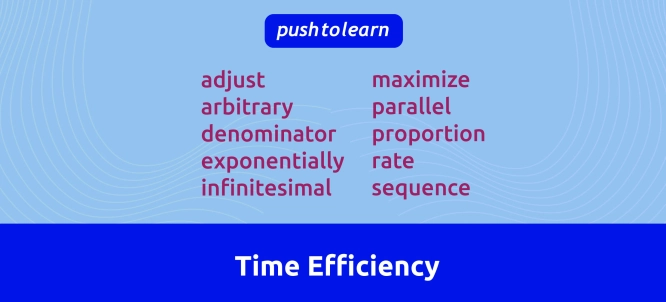by PushtoLearn
Time Efficiency
Table of Contents
Time Efficiency Flashcards - Vocabulary Practice for TOEFL
These exercises focus on Time Efficiency Vocabulary
Vocabulary List for Time Efficiency
1. Adjust (verb)
-
Definition: To change or modify something slightly to improve its effectiveness or accuracy.
-
Example: She adjusted her schedule to include more focused work sessions.
-
Explanation: Knowing how to adjust plans is essential for improving time efficiency and adapting to changes.
2. Arbitrary (adjective)
-
Definition: Based on random choice or personal whim rather than reason or a system.
-
Example: The deadlines seemed arbitrary and didn’t align with the project’s priorities.
-
Explanation: Avoiding arbitrary decisions helps create more efficient and structured workflows.
3. Denominator (noun)
-
Definition: The bottom number in a fraction, representing the whole.
-
Example: When comparing rates of completion, time is often the common denominator.
-
Explanation: Understanding denominators helps in comparing time ratios and evaluating efficiency.
4. Exponentially (adverb)
-
Definition: At an increasingly rapid rate.
-
Example: The team’s productivity improved exponentially once they adopted the new software.
-
Explanation: Exponential growth is a key concept when measuring improvements in efficiency.
5. Infinitesimal (adjective)
-
Definition: Extremely small; almost negligible.
-
Example: The time savings may seem infinitesimal at first, but they add up significantly over weeks.
-
Explanation: Recognizing small time-saving opportunities is important for cumulative efficiency.
6. Maximize (verb)
-
Definition: To make the most of something; to increase to the greatest possible amount.
-
Example: By using templates, she was able to maximize her productivity.
-
Explanation: Maximizing resources and time is the foundation of time efficiency.
7. Parallel (adjective)
-
Definition: Occurring or existing at the same time or in a similar manner.
-
Example: The team worked on parallel tasks to save time.
-
Explanation: Understanding parallel workflows is essential for optimizing multitasking and time allocation.
8. Proportion (noun)
-
Definition: A part, share, or number considered in relation to the whole.
-
Example: A large proportion of her time was spent organizing files.
-
Explanation: Analyzing proportions helps identify areas where time is over- or under-utilized.
9. Rate (noun)
-
Definition: A measure or quantity of something over a specified period of time.
-
Example: The rate of task completion improved after the new process was implemented.
-
Explanation: Measuring rates is crucial for tracking efficiency and progress.
10. Sequence (noun)
-
Definition: A specific order in which related events, movements, or items follow each other.
-
Example: He planned the project steps in a logical sequence to avoid delays.
-
Explanation: Understanding sequences helps streamline workflows and minimize wasted time.

Summary Table
|
Word |
Definition |
Example Sentence |
|
Adjust |
Modify slightly to improve effectiveness. |
"She adjusted her schedule to include focused work sessions." |
|
Arbitrary |
Based on whim, not reason or system. |
"The deadlines seemed arbitrary and unaligned with priorities." |
|
Denominator |
Bottom number in a fraction. |
"Time is often the common denominator in comparisons." |
|
Exponentially |
At an increasingly rapid rate. |
"Productivity improved exponentially after adopting the software." |
|
Infinitesimal |
Extremely small; almost negligible. |
"The time savings seemed infinitesimal at first." |
|
Maximize |
Make the most of something. |
"Using templates helped maximize productivity." |
|
Parallel |
Existing at the same time or manner. |
"The team worked on parallel tasks to save time." |
|
Proportion |
A part in relation to a whole. |
"A large proportion of time was spent organizing files." |
|
Rate |
Measure or quantity over time. |
"The rate of completion improved after the new process." |
|
Sequence |
A specific order of events or items. |
"He planned the steps in a logical sequence to avoid delays." |
Examples in Context
-
Adjust: When the project faced unexpected delays, the team adjusted their approach to prioritize critical tasks.
-
Arbitrary: Arbitrary decisions about meeting times often waste valuable time for the whole team.
-
Denominator: In efficiency analysis, hours worked often serve as the denominator for productivity metrics.
-
Exponentially: With each iteration of the workflow, the team improved their performance exponentially.
-
Infinitesimal: Small, infinitesimal gains in speed can lead to significant results in repetitive tasks.
-
Maximize: By outsourcing non-core activities, the company was able to maximize its focus on innovation.
-
Parallel: Managing parallel projects requires careful coordination to prevent resource conflicts.
-
Proportion: The proportion of time spent on unproductive activities revealed areas for improvement.
-
Rate: Tracking the rate of completed tasks per day helped identify bottlenecks in the process.
-
Sequence: Optimizing the sequence of operations in manufacturing saved both time and materials.
FAQ
How can I remember the difference between "adjust" and "maximize"?
Adjust means making small changes to improve something, while maximize focuses on getting the absolute most out of it. Think of adjusting as fine-tuning and maximizing as pushing limits.
What is a practical use of "exponentially" in real life?
You can use "exponentially" to describe rapid growth, such as in productivity or skill improvement, when the rate of change accelerates over time.
Why is understanding "denominator" important for time efficiency?
Denominators help in comparing ratios, such as productivity per hour, allowing you to measure and optimize tasks relative to time.
Can "infinitesimal" be used to describe anything other than time?
Yes, it can describe anything extremely small, such as infinitesimal changes in temperature or infinitesimal quantities in mathematics.
How do "parallel" and "sequence" relate to each other?
Parallel refers to tasks happening simultaneously, while sequence refers to tasks arranged in a specific order. Combining both concepts effectively can greatly enhance time efficiency.

